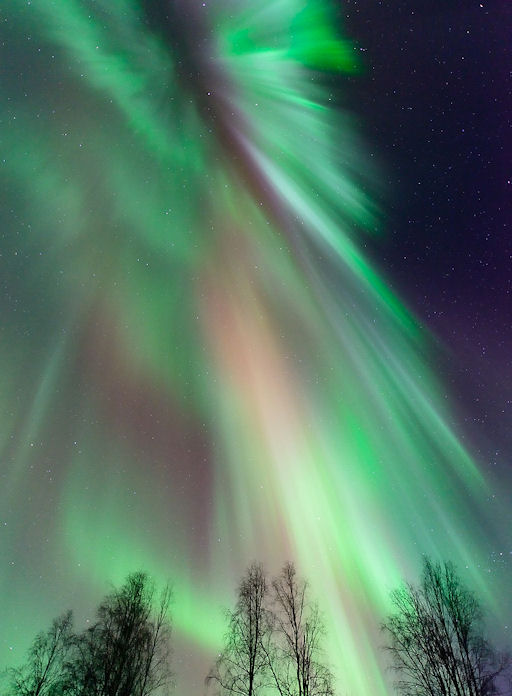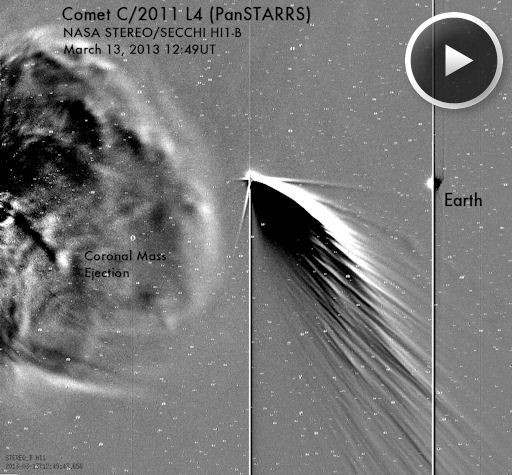Hang the Transit of Venus on your wall! Hubble-quality images from NASA's Solar Dynamics Observatory are now available as metallic posters in the Space Weather Store. | | |
ADVERTISE AT THE EDGE OF SPACE: Spaceweather.com is pleased to announce a unique advertising opportunity. We can launch your ad banner or product to the edge of space itself. Take a look at this running shoe or this bobble-head figure. In collaboration with Earth to Sky Calculus, a student-run corporation based in Bishop, California, Spaceweather.com will fly a helium research balloon to 120,000 feet where your ad, picture, birthday greeting or other item can be photographed against the limb of the Earth. Liftoff is scheduled for 9 am on April 22nd, Earth Day 2013! Contact Dr. Tony Phillips for pricing and details.
AURORAS LOVE EQUINOXES: The seasons are changing. Today, March 20th, the sun is crossing cross the celestial equator heading north. This marks the beginning of spring in the northern hemisphere and autumn in the southern hemisphere. At this time of year, day and night are of nearly equal length, hence the name "equinox" (equal night).
For reasons researchers don't fully understand, auroras love equinoxes. During the weeks around the beginning of spring or fall, the slightest gust of solar wind can provoke bright lights around the poles. A potent CME impact at this time can produce an unforgettable display, like this one only a few days ago:

"I took this photo during the historic St. Patrick's Day geomagnetic storm of 2013," says Ben Hattenbach of Fairbanks, Alaska. "I'm still exhausted from the experience, during which the aurora was at or near peak strength for the entire night. It was just incredible in a way pictures cannot come close to conveying."
With the beginning of northern spring, the stage is set for more auroras tonight. NOAA forecasters estimate a 20% - 30% chance of polar geomagnetic storms on March 20-21. Aurora alerts: text, voice.
Realtime Aurora Photo Gallery
COMET DODGES CMEs: NASA's STEREO-B spacecraft has been monitoring Comet Pan-STARRS, taking hundreds of pictures as the comet passed by the sun this month. Yesterday, analyst Karl Battams of the Naval Research Lab assembled the data into a single movie spanning eight days, from March 9th through 16th. Click to set the scene in motion:

STEREO-B is stationed over the farside of the sun, so cameras onboard the spacecraft can look back and see Earth as well as the comet. In Battams' movie, the sun is located just outside the field of view on the left. Massive clouds of magnetized plasma (CMEs) billow away from the sun toward the comet, but according to Battams, none hit their mark:
"There were two CMEs in that sequence and it seems they went either side of the comet," he says. "That's a shame for us scientists because we would like to study how CMEs interact with a comet."
CMEs have been known to rip the tails off comets that pass too close to the sun, but that did not happen to Comet Pan-STARRS.
"By the way," adds Battams, "I've looked closely at the STEREO images and can see no indication of the possible fragment recently reported on spaceweather.com. I also haven't noticed any unusual brightening or disruption in the comet tail that would hint at such a fragmentation event having occurred."
More: NASA video, 3D orbit, ephemeris, light curves.
Realtime Comet Photo Gallery
Realtime Space Weather Photo Gallery
Realtime Noctilucent Cloud Photo Gallery
[previous years: 2003, 2004, 2005, 2006, 2007, 2008, 2009, 2011]

